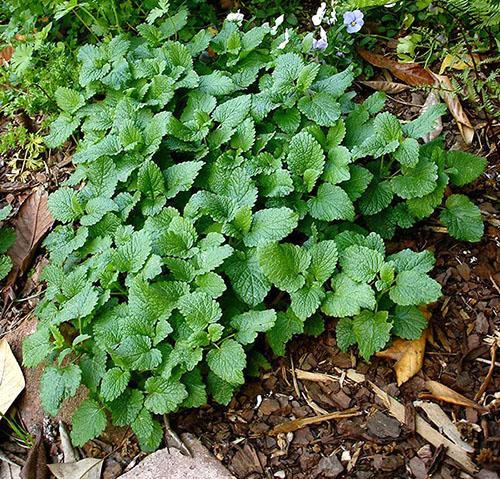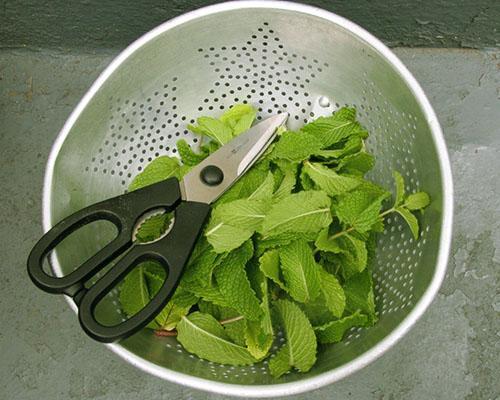Photos, cultivation and methods of harvesting lemon mint
 Melissa, among other varieties of mint, stands out with citrus notes in the scent and belongs to the labiate family. In Europe, where the plant has long been cultivated as a spicy-flavoring culture, lemon balm is called lemon mint. This name has taken root in Russia as well.
Melissa, among other varieties of mint, stands out with citrus notes in the scent and belongs to the labiate family. In Europe, where the plant has long been cultivated as a spicy-flavoring culture, lemon balm is called lemon mint. This name has taken root in Russia as well.
The lemon mint plant, as in the photo, reaches a height of 30–100 cm and consists of powerful, erect, pubescent stems, on which are heart-shaped or oval leaves with noticeable rounded teeth at the edges.
It is in the leaves and upper parts of the shoots that most of the aromatic and useful substances are contained, and the pale pink or almost white lemon balm flowers attract a lot of bees every summer.
As a wonderful spice and honey plant, lemon mint is highly valued by gardeners and gardeners. Grass lemon balm it is used in many recipes of traditional medicine, and cooks are happy to add fragrant foliage to marinades, vegetable and fish dishes. Melissa enhances the taste and aroma of baked poultry, sweet pastries and cheeses. Fragrant greens are irreplaceable in refreshing and medicinal tea mixtures, cocktails.

How to prepare mint for tea for the winter?
 Cutting fresh herbs is carried out in clear cool weather, when there is no dew or traces of rain on the plants. The best time to harvest is in the morning and evening hours, when the scorching rays of the sun will not cause the leaves and tops of the stems to fade and lose such a valuable aroma. The greatest concentration of essential oils, vitamins and other substances important for the body in lemon balm greens accumulates at the time of flowering, therefore, at this time, the greenery is cut to prepare mint for winter tea.
Cutting fresh herbs is carried out in clear cool weather, when there is no dew or traces of rain on the plants. The best time to harvest is in the morning and evening hours, when the scorching rays of the sun will not cause the leaves and tops of the stems to fade and lose such a valuable aroma. The greatest concentration of essential oils, vitamins and other substances important for the body in lemon balm greens accumulates at the time of flowering, therefore, at this time, the greenery is cut to prepare mint for winter tea.
 As soon as the upper juicy parts of the shoots are collected, the plant materials are washed, and the lemon mint greens, as in the photo, are carefully dried with paper or linen napkins. You can find recommendations where plant raw materials are advised not to wash, but to blanch before drying:
As soon as the upper juicy parts of the shoots are collected, the plant materials are washed, and the lemon mint greens, as in the photo, are carefully dried with paper or linen napkins. You can find recommendations where plant raw materials are advised not to wash, but to blanch before drying:
- On the one hand, this will help preserve the initially green color of the leaves, which will have a positive effect on the appearance of dishes and drinks with lemon balm.
- On the other hand, if you delay, lemon mint leaves quickly become soft, lose their elasticity and when dried or frozen, they completely lose their shape.
It is rational to blanch lemon mint if it is decided to make syrup, aromatic sugar from it for the winter, or freeze it in the form of portioned cubes, since even with short-term heating, the release of juice increases.
Drying lemon mint at home
 Preparing mint for tea for the winter, small bunches are formed from the shoots, which are hung away from heating appliances and direct rays. With a constant flow of air and a dry atmosphere, the grass dries up within a few days.
Preparing mint for tea for the winter, small bunches are formed from the shoots, which are hung away from heating appliances and direct rays. With a constant flow of air and a dry atmosphere, the grass dries up within a few days.
 During drying, it is better to protect the plants from insect and dust attack by covering the bundles with gauze. If the grass is dried with the help of modern electric dryers, the most gentle modes are used, and, as in the photo, the lemon mint is laid out on pallets in an even thin layer and from time to time it is turned.
During drying, it is better to protect the plants from insect and dust attack by covering the bundles with gauze. If the grass is dried with the help of modern electric dryers, the most gentle modes are used, and, as in the photo, the lemon mint is laid out on pallets in an even thin layer and from time to time it is turned.
 The dried leaves and the tops of the stems are crushed and placed in tight-fitting glass jars, where the lemon balm is to be stored all winter.
The dried leaves and the tops of the stems are crushed and placed in tight-fitting glass jars, where the lemon balm is to be stored all winter.
Can mint be frozen for the winter?
Melissa, like other varieties of mint, can be prepared for the winter by freezing whole shoots and individual leaves.
 For this, the washed and dried bundles are packed in foil, cling film or resealable tight bags and placed in small portions for storage in a freezer. You can freeze mint for the winter in the form of very convenient ice cubes, which for several months will be useful for flavoring tea, sauces, and obtaining medicinal broths.
For this, the washed and dried bundles are packed in foil, cling film or resealable tight bags and placed in small portions for storage in a freezer. You can freeze mint for the winter in the form of very convenient ice cubes, which for several months will be useful for flavoring tea, sauces, and obtaining medicinal broths.
When frozen, lemon balm completely retains its taste and smell, but the leaves completely lose their shape. Therefore, for the manufacture of such cubes, you can take both greens and juicy stems, having previously chopped them in a blender.
Harvesting lemon mint for a sweet tooth
 On the basis of lemon mint, as in the photo, you can make very fragrant sugar, which will surely please not only a lover of sweet tea, but also housewives who pamper their loved ones with fragrant pastries and homemade pastries. For such an unusual seasoning, take fresh lemon balm, and grind it, while mixing with sugar. For 200 grams of plant materials, take 200 grams of regular sugar. If desired, lemon zest, thyme herb or other varieties of mint are added to the composition.
On the basis of lemon mint, as in the photo, you can make very fragrant sugar, which will surely please not only a lover of sweet tea, but also housewives who pamper their loved ones with fragrant pastries and homemade pastries. For such an unusual seasoning, take fresh lemon balm, and grind it, while mixing with sugar. For 200 grams of plant materials, take 200 grams of regular sugar. If desired, lemon zest, thyme herb or other varieties of mint are added to the composition.
How else can you prepare mint for tea for the winter? Lemon balm syrup will be no less joy for those with a sweet tooth.
 100 grams of clean dry or blanched greens will require 100 grams of water and 200 grams of sugar, half of which is poured into crushed lemon mint and left for 8-12 hours for the grass to give juice. When the sugar has practically dissolved, pour the lemon mint over the sugar syrup and bring the mixture to a boil. The container with syrup removed from the fire is cooled, the finished product is filtered and poured into sterilized jars or bottles with well-ground lids.
100 grams of clean dry or blanched greens will require 100 grams of water and 200 grams of sugar, half of which is poured into crushed lemon mint and left for 8-12 hours for the grass to give juice. When the sugar has practically dissolved, pour the lemon mint over the sugar syrup and bring the mixture to a boil. The container with syrup removed from the fire is cooled, the finished product is filtered and poured into sterilized jars or bottles with well-ground lids.
You can store mint syrup in the refrigerator, and use it to add to tea, pastry, cereals and fruit salads.
There are a lot of ways to prepare lemon mint for the winter for tea and other dishes today. For example, aromatic oils and sauces are made on the basis of aromatic herbs. But you can take advantage of the unpretentiousness of the plant and try to grow a lemon mint bush in a pot at home.
How to grow mint at home?
 The easiest way is to separate part of an adult lemon mint bush in your own garden in the fall, as in the photo, and transfer it, along with a lump of earth, to a spacious pot, where a drainage layer is pre-equipped. To fill the pot, you can take both loose garden soil and ready-made soil for seedlings or green crops.
The easiest way is to separate part of an adult lemon mint bush in your own garden in the fall, as in the photo, and transfer it, along with a lump of earth, to a spacious pot, where a drainage layer is pre-equipped. To fill the pot, you can take both loose garden soil and ready-made soil for seedlings or green crops.
Melissa does not like acidic soils, therefore, if necessary, dolomite flour is added to the soil.
 If it is impossible to get an already rooted plant, do not despair. Melissa gives roots in a few days if the lower leaves are removed from cuttings 15 - 20 cm long and the stems are immersed in water with a few drops of a growth stimulant. After about a week, young plants with their own root system are planted in the ground. From this moment at home, mint can grow in a pot for more than one year, delighting family members with fresh greens. Subsequently, the plant requires moderate glaze, spraying with dry air and its elevated temperature.
If it is impossible to get an already rooted plant, do not despair. Melissa gives roots in a few days if the lower leaves are removed from cuttings 15 - 20 cm long and the stems are immersed in water with a few drops of a growth stimulant. After about a week, young plants with their own root system are planted in the ground. From this moment at home, mint can grow in a pot for more than one year, delighting family members with fresh greens. Subsequently, the plant requires moderate glaze, spraying with dry air and its elevated temperature.
The most laborious and time consuming way is to grow mint at home from seeds.
The best time for sowing is spring, but since it is desirable to get fresh greens in winter, you will have to plant seeds in the ground at the end of summer or in autumn, when the length of daylight decreases every day. In this case, the lightest place on the windowsill is chosen for lemon balm, and even better, to equip houses for mint in a pot additional illumination.
 In a container with soil mixture, shallow grooves are made at a distance of 5–7 cm, the soil is moistened and dry seeds are sown. As needed, the soil is moistened, and the seedlings should wait about a week. If the sprouts have sprouted too tightly, they are thinned out or dived. In order for the lemon mint to form a healthy strong bush, the brightest place on the window or balcony is chosen for lemon balm.
In a container with soil mixture, shallow grooves are made at a distance of 5–7 cm, the soil is moistened and dry seeds are sown. As needed, the soil is moistened, and the seedlings should wait about a week. If the sprouts have sprouted too tightly, they are thinned out or dived. In order for the lemon mint to form a healthy strong bush, the brightest place on the window or balcony is chosen for lemon balm.
Watering is carried out up to 3 times a week. To prevent flowering and weakening of the plant, when the shoots of housemint in a pot reach a height of 15–20 cm, the tops of the stems are shortened. Such a measure will lead to the appearance of lateral branches and an increase in the amount of foliage.
When cut off to dry or freeze the stems, home grown lemon mint yields up to three full harvests over the winter.
But more often, such a home plant supplies the family with fragrant foliage every day for tea, medicinal cold remedies and other popular lemon mint remedies.